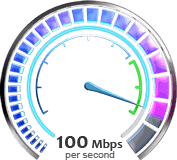About
A Blazing Speed Internet


FIBER TO THE HOME ( FTTH )
Fiber to the home (FTTH) is the delivery of a communications signal over optical fiber from the operator’s switching equipment all the way to a home or business, thereby replacing existing copper infrastructure such as telephone wires and coaxial cable. Fiber to the home is a relatively new and fast growing method of providing vastly higher bandwidth to consumers and businesses,and thereby enabling more robust video, internet and voice services. Connecting homes directly to fiber optic cable enables enormous improvements in the bandwidth that can be provided to consumers. Current fiber optic technology can provide two-way transmission speeds of up to 100 megabits per second. Further, as cable modem and DSL providers are struggling to squeeze increments of higher bandwidth out of their technologies, ongoing improvements in fiber optic equipment are constantly increasing available bandwidth without having to change the fiber. That’s why fiber networks are said to be future proof.
Pros
While FTTH promises connection speeds of up to 100 megabits per second (Mbps) -- 20 to 100 times as fast as a typical cable modem or DSL (Digital Subscriber Line) connection -- implementing FTTH on a large scale will be costly because it will require installation of new cable sets over the "last links" from existing optical fiber cables to individual users.


